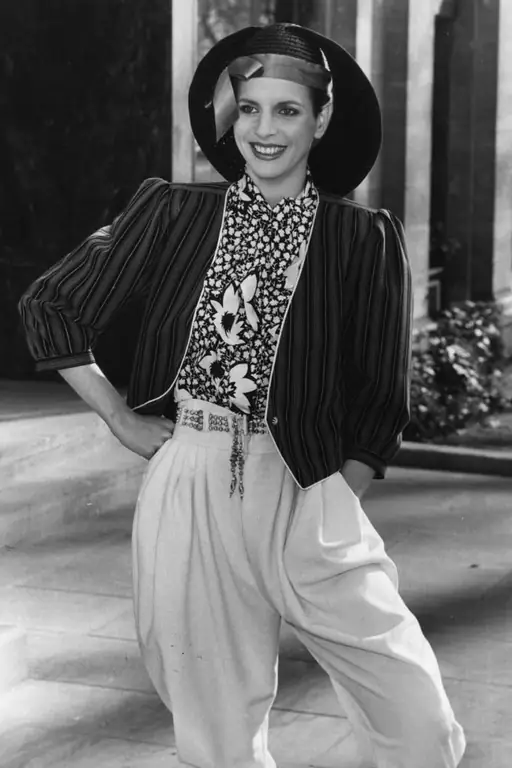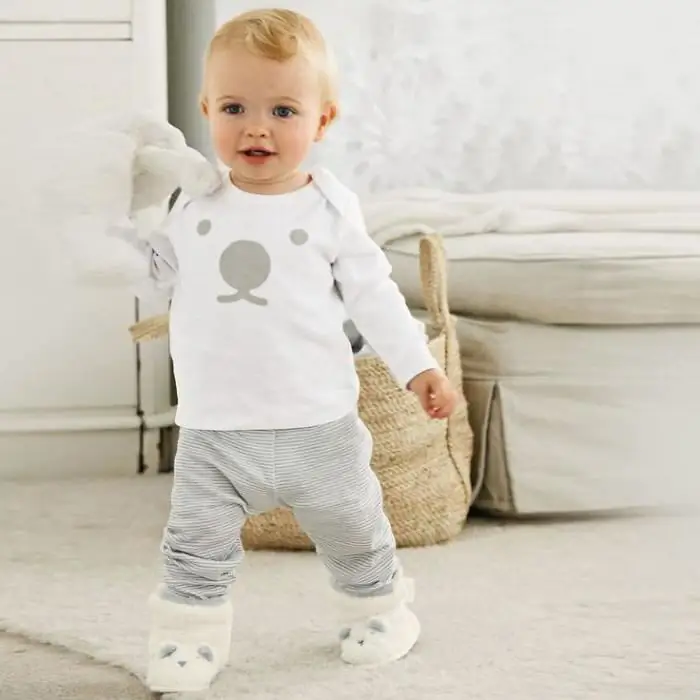
Inhaltsverzeichnis:
- Autor Sierra Becker [email protected].
- Public 2024-02-26 04:44.
- Zuletzt bearbeitet 2025-06-01 05:43.
Alle Näherinnen wissen, wie viel man das Familienbudget sparen kann, wenn man für die Familie und für sich selbst näht. Oft ist die Schneiderei um ein Vielfaches billiger und die Dinge sind von besserer Qualität als die auf dem Markt erhältlichen. Um ein hervorragendes Ergebnis zu erzielen, ist natürlich Erfahrung erforderlich, aber selbst wenn sie nicht vorhanden ist, ist eine solche Übung nicht umsonst und wird sich sicherlich bei der Herstellung anderer Dinge als nützlich erweisen. Also, es ist Zeit, sich mit einer Schere, einer Nähmaschine und einem Zentimeterband zu bewaffnen, Materialien zu kaufen und sich an die Arbeit zu machen.

Ein bisschen Theorie wird Ihnen helfen zu verstehen, wie ein Damenmantelmuster aufgebaut ist. Tatsächlich ist die Zeichnung nicht kompliziert, und der Prozess selbst besteht darin, die von der Figur genommenen Maße auf Papier zu übertragen, um die Produktvorlage zu entwerfen. Daher ein wenig Fleiß und Geduld - und Sie können sich am Ergebnis erfreuen. Viele Nähzeitschriften bieten ein fertiges Mantelmuster anweiblich. Burda zum Beispiel ist einer der beliebtesten. Die unabhängige Konstruktion hat jedoch eine Reihe von Vorteilen, da keine allgemein anerkannten Standardmaße für eine bestimmte Größe verwendet werden, sondern persönliche Maße. Dadurch sitzt das Produkt viel besser auf der Figur.
Dieser Artikel behandelt einen Damenmantel: ein Muster, nach dem er genäht wird, und seine Konstruktion sowie Materialien, die am besten bei der Arbeit verwendet werden.
Messung
Damit das Produkt gut auf der Figur sitzt und alle Kurven des Körpers ohne F alten und zusätzliche F alten wiederholt, muss es unter Berücksichtigung der Eigenschaften des Körpers genäht werden. Dafür sind Messungen da. Die Mustergrundlage eines Damenmantels erfordert folgende Maße: Volumen von Hals, Brust, Taille, Hüfte, Oberarm, Brustabnäher, Rückenbreite, Höhe von der Schulter bis zur Brustmitte, bis zur Taille (entlang des Rückens und entlang der vorne durch die Brust), Schulterbreite, Ärmellänge und das gesamte Produkt. Alle diese Werte müssen notiert werden und Sie können mit der Arbeit an der Zeichnung beginnen.

Die erste Phase des Aufbaus der Basis: das Gitter
Wie die meisten Produkte ist das Wintermantelmuster für Damen in einem Rechteck aufgebaut, das durch zusätzliche Linien in Abschnitte unterteilt ist. Es wird als Basisgitter bezeichnet. Die vertikale Seite des Rechtecks sollte gleich der Länge des Produkts sein, und die horizontale Seite sollte gleich dem Maß „Brustvolumen“+ 3 cm für eine freie Passform sein. Die Obergrenze definiert das Leverage-Level. Von dort aus müssen Sie auf die Höhe der Brust hinuntergehen und eine horizontale Linie im Brustbereich zeichnen, tiefer - die Taille und noch tiefer - die Hüften.
Aus der VertikalenSeiten entlang der linken Brustlinie müssen Sie die Hälfte der Brustbreite und von rechts die Hälfte der Lösung der Biesen beiseite legen. Heben Sie Senkrechte von den erh altenen Punkten an. Nachdem der Halbumfang der Brust in 4 Teile geteilt und 2 cm zum resultierenden Wert addiert werden sollte, sollte der entsprechende Abstand auf der Brustlinie von dem Punkt, der die Breite des Rückens bestimmt, beiseite gelegt werden, einen Punkt setzen und anheben die Senkrechte. So kommt das Grundraster zum Vorschein, wo bereits die Rückenzone, die Armlochzone und die vordere Regalzone angedeutet sind. Der Armlochbereich entlang der Brustlinie muss in zwei Hälften geteilt werden und die Senkrechte sollte abgesenkt werden - dies ist die Grenze der Seitennaht des Produkts. Auf der Grundlage dieses Rasters wird jedes Produkt gebaut, einschließlich Damenmäntel. Das Muster muss in diesem Stadium fertiggestellt werden und kann als Vorlage verwendet werden.

Die zweite Phase des Baus der Basis: Details
Der Rest des Prozesses besteht darin, die Details zu verfeinern.
- In den oberen Ecken des Rechtecks ¼ Messungen des Halsumfangs zurücktreten und den Hals zeichnen. Vertiefung auf der Rückseite um 3 cm, auf der Vorderseite - um 7 cm.
- Die Schulterpartien werden aus den erh altenen Punkten aufgebaut. Sie sollten etwa 1,5 cm zur Mitte des Rechtecks hin abgeschrägt sein.
- Ziehen Sie sich auf der Schulter des vorderen Regals von der Senkrechten, die vom Rand der Einstecklösung angehoben wurde, 3 cm zurück und senken Sie die gerade Linie auf denselben Punkt. Die Schulternaht verlängert sich um die gleiche Strecke (3 cm). Das wird die Büste sein.
- Von den Schulterpunkten ein Armloch bis zum Mittelpunkt zeichnen, wo die Seitennaht herauskommt.
- Wenn das Modell dies nicht bietetTaillenf alten, dann sofort zur Hüftlinie bewegen. Legen Sie von den Vertikalen des Rechtecks entlang der entsprechenden Linie die Hälfte des Maßes des Hüftumfangs ab und setzen Sie Punkte. Seitennähte erweitern sich ggf. von der Mitte des Armlochs bis zu den Hüften. Auf Wunsch kann die Manteloberseite auch trapezförmig gest altet werden.
- Wenn Biesen vorhanden sind, wird die Differenz zwischen den Volumina von Hüfte und Taille ermittelt und der resultierende Wert auf Biesen verteilt. Ihre Oberseite sollte die Brustlinie erreichen und die Unterseite sollte in einem Abstand von 5 cm von der Hüftlinie enden.

Ärmel bauen
Was kann ein Frauenmantel sein? Das Muster kann mit einer einteiligen Hülse oder mit einer eingesetzten Hülse aufgebaut werden. Die erste Option ist einfacher und sieht die Verlängerung der Schulternaht um das erforderliche Maß und die Konstruktion des unteren Ärmelabschnitts aus der Seitennaht vor. Dies ist die perfekte Option für einen Anfänger. Wenn Sie bereits ein wenig Übung im Nähen haben, können Sie an einem eingesetzten Ärmel arbeiten.
Um eine solche Hülle zu bauen, benötigen Sie fertige Muster von Regalen. Hier müssen Sie das Auge auf dem fertigen Armloch umkreisen. Dazu werden die Regalschablonen über die Schulter gef altet und der Schnitt kreisrund gemacht. Nachdem es um 1,5 cm überschätzt wurde, wird auf seiner Basis ein gleichmäßiger Kreis gezeichnet. Entlang des unteren Randes dieses Kreises wird eine Linie gezogen, auf der sie die Breite des Oberarms + 2 cm für eine freie Passform angeben. Als nächstes müssen die Linien für die Naht des Ärmels nach unten gesenkt und der Kreis in einem Kreis umrissen werden, der zu den Punkten der Grenze der Armbreite führt. Zu diesem Zeitpunkt sind alle Vorlagen fertig und Sie können einen Damenmantel ausschneiden. Das Muster dieses Produkts kannsowohl für warme Produkte als auch für eine Sommerjacke verwendet werden. Es müssen lediglich unterschiedliche Zugaben für eine lockere Passform und Isolierung des Produkts hinzugefügt werden.

Simulation
Das fertige Muster des Damenmantels kann fertiggestellt werden. Hier können Sie Prägenähte, Taschen, zusätzliche Zierelemente wie Riegel für Verschlüsse, einen doppelten Rücken im Bereich der Schulterblätter und so weiter benennen. Sie können auch an Schultergurte, einen Riemen auf der Rückseite in der Taille und andere Elemente denken.
Stoff wählen
Für Mäntel wählst du am besten weiche und warme Stoffe wie Polar oder Kaschmir. Aber hier ist es erwähnenswert, dass solche Dinge oft vom Wind verweht werden. Wenn Sie also einen warmen Wintermantel brauchen, dann wäre die beste Option ein Regenmantelstoff mit spezieller Imprägnierung, der mit synthetischem Winterizer oder einer anderen Isolierung dupliziert werden sollte.
Empfohlen:
Die Wirkung eines alten Fotos: wie man Vintage-Fotos macht, die Wahl eines Programms zum Arbeiten mit Fotos, die notwendigen Bildbearbeitungsprogramme, Filter für die Bearbeitung

Wie kann man den Effekt eines alten Fotos in einem Bild erzeugen? Was ist das? Warum sind Vintage-Fotos so beliebt? Grundprinzipien der Bearbeitung solcher Fotos. Eine Auswahl von Anwendungen für Smartphones und Computer zur Retro-Bildverarbeitung
Muster eines Kinderpyjamas für einen Jungen und ein Mädchen: Beschreibung, Diagramm und Empfehlungen

Was ist der Schlüssel zu guter Laune und Fröhlichkeit für den ganzen Tag? Gesunder und fester Schlaf. Deshalb müssen sich sowohl Kinder als auch Erwachsene mit maximalem Komfort entspannen, gekleidet in sanfte und weiche Pyjamas. Muster von Kinderpyjamas, Empfehlungen für die Auswahl von Stoffen und Farben - das alles finden Sie in diesem Artikel
Poncho: Muster mit Beschreibungen. Erstellen eines Musters eines Damenponchos

Poncho ist ein Kleidungsstück, das von den südamerikanischen Indianern zu uns kam. Seine Bequemlichkeit zieht viele an, und Sie können solche Kleider selbst nähen oder stricken
Eine Tunika für Frauen stricken: eine Schritt-für-Schritt-Meisterklasse

Strickwaren haben seit vielen Jahren nicht an Aktualität verloren. Und jetzt sind sie sehr beliebt. Außerdem möchte man nicht nur warm h alten, sondern auch noch richtig gut aussehen. Daher setzen viele, meist junge Damen, ihre Lieblingsoption lieber alleine um. Aber nicht jeder versteht, aus welchen Phasen dieser Prozess besteht
Muster eines Babyunterhemds für ein Neugeborenes, ein Muster einer Mütze und eines Overalls

Die Vorbereitung einer Mitgift für ein Baby ist eine sehr aufregende und interessante Aktivität, die der werdenden Mutter viel Freude und positive Emotionen bereiten wird. Und weg von allen Vorurteilen, die sagen, man könne sich nicht vorbereiten. Die Schwangerschaft ist die Zeit, Handarbeiten zu machen und schöne und originelle Dinge für Ihr Baby zu kreieren. Denn wenn das Baby auf der Welt ist, dann bleibt bestimmt nicht genug Zeit für das Sammeln an der Nähmaschine und das Stricken
